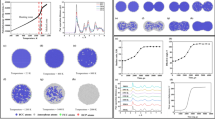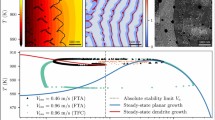Abstract
Spallation, rupture under impulsive tensile loading, is a dynamic failure process involving the collective evolution and accumulation of enormous microdamage in solids. In contrast to traditional alloys, the spallation mechanism in medium entropy alloys, the recently emerged multiprinciple and chemically disordered alloys, is poorly understood. Here we conduct molecular dynamics simulations and first principle calculations to investigate the effects of impact velocities and the local chemical order on spallation microvoid nucleation in a CrCoNi medium entropy alloy under shock wave loading. As the impact velocity increases, the microvoid nucleation site exhibits a transition from the grain boundaries to the grains to release redundant imposed energy. During the intragranular nucleation process, microvoids nucleate in the poor-Cr region with a large local nonaffine deformation, which is attributed to the weak metallic bonds in this position with sparse free electrons. For intergranular nucleation, a Franke-like dislocation source forms through the dislocation reaction, leading to enormous dislocations piling up in a narrow twin stripe, which markedly increases the local stored energy and promotes microvoid nucleation. These results shed light on the mechanism of spallation in chemically complexed medium entropy alloys.
Similar content being viewed by others
References
Hopkinson B. X. A method of measuring the pressure produced in the detonation of high, explosives or by the impact of bullets. Philos Trans R Soc London Ser A, 1914, 213: 437–456
Curran D. Dynamic failure of solids. Phys Rep, 1987, 147: 253–388
Bai Y L, Xia M, Ke F. Statistical Meso-Mechanics of Damage and Failure: How Microdamage Induces Disaster. Singapore: Springer, 2019
Teng H H, Jiang Z L, Progress in multi-wave structure and stability of oblique detonations. Adv Mech, 2020, 50: 202002
Jiao W, Chen X. Review on long-rod penetration at hypervelocity. Adv Mech, 2019, 49: 312–391
Tan M, Zhang X, Bao K, et al. Interface defeat of ceramic armor. Adv Mech, 2019, 49: 392–427
Liu X F, Tian Z L, Zhang X F, et al. “Self-sharpening” tungsten high-entropy alloy. Acta Mater, 2020, 186: 257–266
Bai Y L, Wang H Y, Xia M F, et al. Statistical mesomechanics of solid, linking coupled multiple space and time scales. Appl Mech Rev, 2005, 58: 372–388
Meyers M A, Taylor Aimone C. Dynamic fracture (spalling) of metals. Prog Mater Sci, 1983, 28: 1–96
Raj R, Ashby M F. Intergranular fracture at elevated temperature. Acta Metall, 1975, 23: 653–666
Reina C, Marian J, Ortiz M. Nanovoid nucleation by vacancy aggregation and vacancy-cluster coarsening in high-purity metallic single crystals. Phys Rev B, 2011, 84: 104117
Fensin S J, Escobedo J P, Gray Iii G T, et al. Dynamic damage nucleation and evolution in multiphase materials. J Appl Phys, 2014, 115: 203516
Marian J, Knap J, Ortiz M. Nanovoid cavitation by dislocation emission in aluminum. Phys Rev Lett, 2004, 93: 165503
Meyers M A, Traiviratana S, Lubarda V A, et al. The role of dislocations in the growth of nanosized voids in ductile failure of metals. JOM, 2009, 61: 35–41
Gurson A L. Continuum theory of ductile rupture by void nucleation and growth: Part I—Yield criteria and flow rules for porous ductile media. J Eng Mater Tech, 1977, 99: 2–15
Needleman A. A continuum model for void nucleation by inclusion debonding. J Appl Mech, 1987, 54: 525–531
Huang X, Ling Z, Dai L H. Influence of surface energy and thermal effects on cavitation instabilities in metallic glasses. Mech Mater, 2019, 131: 113–120
Huang X, Ling Z, Dai L H. Cavitation instabilities in bulk metallic glasses. Int J Solids Struct, 2013, 50: 1364–1372
Cantor B, Chang I T H, Knight P, et al. Microstructural development in equiatomic multicomponent alloys. Mater Sci Eng-A, 2004, 375–377: 213–218
Yeh J W, Chen S K, Lin S J, et al. Nanostructured high-entropy alloys with multiple principal elements: Novel alloy design concepts and outcomes. Adv Eng Mater, 2004, 6: 299–303
Gludovatz B, Hohenwarter A, Catoor D, et al. A fracture-resistant high-entropy alloy for cryogenic applications. Science, 2014, 345: 1153–1158
George E P, Raabe D, Ritchie R O. High-entropy alloys. Nat Rev Mater, 2019, 4: 515–534
Murty B S, Yeh J W, Ranganathan S, et al. High-Entropy Alloys. Elsevier, 2019
Shi P, Ren W, Zheng T, et al. Enhanced strength-ductility synergy in ultrafine-grained eutectic high-entropy alloys by inheriting microstructural lamellae. Nat Commun, 2019, 10: 489
Liang Y X, Yang X F, Ming K S, et al. In situ observation of transmission and reflection of dislocations at twin boundary in CoCrNi alloys. Sci China Tech Sci, 2021, 64: 407–413
Jia B, Liu X J, Wang H, et al. Microstructure and mechanical properties of FeCoNiCr high-entropy alloy strengthened by nano-Y2O3 dispersion. Sci China Tech Sci, 2018, 61: 179–183
Huang T D, Jiang L, Zhang C L, et al. Effect of carbon addition on the microstructure and mechanical properties of CoCrFeNi high entropy alloy. Sci China Tech Sci, 2018, 61: 117–123
Liu J P, Chen J X, Liu T W, et al. Superior strength-ductility CoCrNi medium-entropy alloy wire. Scripta Mater, 2020, 181: 19–24
Pu Z, Xie Z C, Sarmah R, et al. Spatio-temporal dynamics of jerky flow in high-entropy alloy at extremely low temperature. Philos Mag, 2021, 101: 154–178
Pu Z, Chen Y, Dai L H. Strong resistance to hydrogen embrittlement of high-entropy alloy. Mater Sci Eng-A, 2018, 736: 156–166
Soundararajan C K, Luo H, Raabe D, et al. Hydrogen resistance of a 1 GPa strong equiatomic CoCrNi medium entropy alloy. Corrosion Sci, 2020, 167: 108510
Jiang Z J, He J Y, Wang H Y, et al. Shock compression response of high entropy alloys. Mater Res Lett, 2016, 4: 226–232
Li Z, Zhao S, Alotaibi S M, et al. Adiabatic shear localization in the CrMnFeCoNi high-entropy alloy. Acta Mater, 2018, 151: 424–431
Ding Q, Zhang Y, Chen X, et al. Tuning element distribution, structure and properties by composition in high-entropy alloys. Nature, 2019, 574: 223–227
Zhang R, Zhao S, Ding J, et al. Short-range order and its impact on the CrCoNi medium-entropy alloy. Nature, 2020, 581: 283–287
Plimpton S. Fast parallel algorithms for short-range molecular dynamics. J Comput Phys, 1995, 117: 1–19
Hirel P. Atomsk: A tool for manipulating and converting atomic data files. Comput Phys Commun, 2015, 197: 212–219
Li Q J, Sheng H, Ma E. Strengthening in multi-principal element alloys with local-chemical-order roughened dislocation pathways. Nat Commun, 2019, 10: 3563
Falk M L, Langer J S. Dynamics of viscoplastic deformation in amorphous solids. Phys Rev E, 1998, 57: 7192–7205
Stukowski A. Visualization and analysis of atomistic simulation data with OVITO—the open visualization tool. Model Simul Mater Sci Eng, 2010, 18: 015012
Stukowski A. Structure identification methods for atomistic simulations of crystalline materials. Model Simul Mater Sci Eng, 2012, 20: 045021
Stukowski A. Computational analysis methods in atomistic modeling of crystals. JOM, 2014, 66: 399–407
Stukowski A, Bulatov V V, Arsenlis A. Automated identification and indexing of dislocations in crystal interfaces. Model Simul Mater Sci Eng, 2012, 20: 085007
Zurek A K, Thissell W R, Johnson J N, et al. Micromechanics of spall and damage in tantalum. J Mater Processing Tech, 1996, 60: 261–267
Escobedo J P, Cerreta E K, Dennis-Koller D. Effect of crystalline structure on intergranular failure during shock loading. JOM, 2014, 66: 156–164
Guan P, Lu S, Spector M J B, et al. Cavitation in amorphous solids. Phys Rev Lett, 2013, 110: 1–5
Huang X, Ling Z, Zhang H S, et al. How does spallation microdamage nucleate in bulk amorphous alloys under shock loading? J Appl Phys, 2011, 110: 103519
Şopu D, Stukowski A, Stoica M, et al. Atomic-level processes of shear band nucleation in metallic glasses. Phys Rev Lett, 2017, 119: 195503
Zeng F, Jiang M Q, Dai L H. Dilatancy induced ductile-brittle transition of shear band in metallic glasses. Proc R Soc A, 2018, 474: 20170836
van de Walle A, Asta M, Ceder G. The alloy theoretic automated toolkit: A user guide. Calphad, 2002, 26: 539–553
Savin A, Nesper R, Wengert S, et al. ELF: The electron localization function. Angew Chem Int Ed Engl, 1997, 36: 1808–1832
Nelson R, Ertural C, George J, et al. LOBSTER: Local orbital projections, atomic charges, and chemical-bonding analysis from projector-augmented-wave-based density-functional theory. J Comput Chem, 2020, 41: 1931–1940
Lobzenko I, Shiihara Y, Iwashita T, et al. Shear softening in a metallic glass: First-principles local-stress analysis. Phys Rev Lett, 2020, 124: 085503
Hassani M, Lagogianni A E, Varnik F. Probing the degree of heterogeneity within a shear band of a model glass. Phys Rev Lett, 2019, 123: 195502
Author information
Authors and Affiliations
Corresponding authors
Additional information
This work was supported by the National Key Research and Development Program of China (Grant No. 2017YFB0702003), the National Natural Science Foundation of China (NSFC) (Grant Nos. 11790292, 11972346 and 11672316), the NSFC Basic Science Center Program for “Multiscale Problems in Nonlinear Mechanics” (Grant No. 11988102), the Strategic Priority Research Program of the Chinese Academy of Sciences (Grant Nos. XDB22040302 and XDB22040303), the Key Research Program of Frontier Sciences of the Chinese Academy of Sciences (Grant No. QYZDJSSW-JSC011), and the Science Challenge Project (Grant No. TZ2018001).
Rights and permissions
About this article
Cite this article
Xie, Z., Chen, Y., Wang, H. et al. Atomic-level mechanism of spallation microvoid nucleation in medium entropy alloys under shock loading. Sci. China Technol. Sci. 64, 1360–1370 (2021). https://doi.org/10.1007/s11431-021-1814-y
Received:
Accepted:
Published:
Issue Date:
DOI: https://doi.org/10.1007/s11431-021-1814-y




